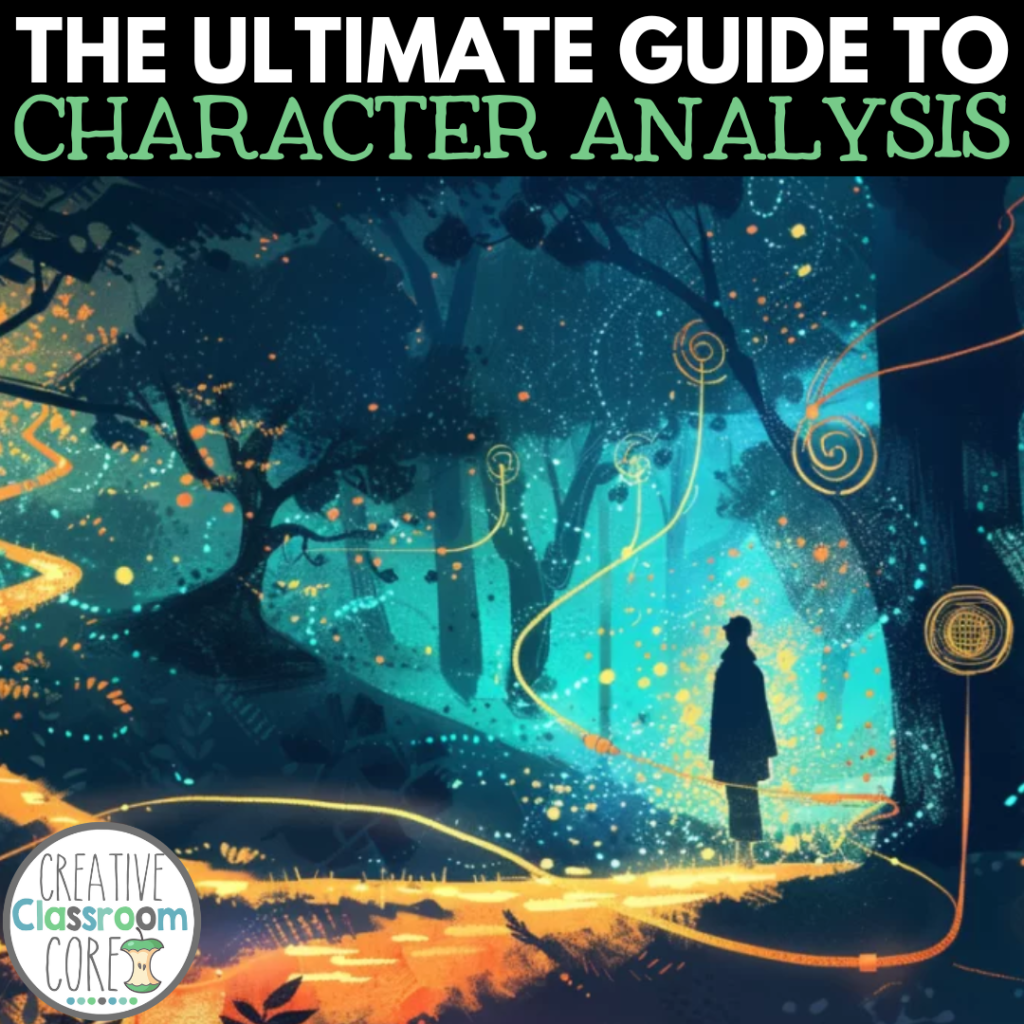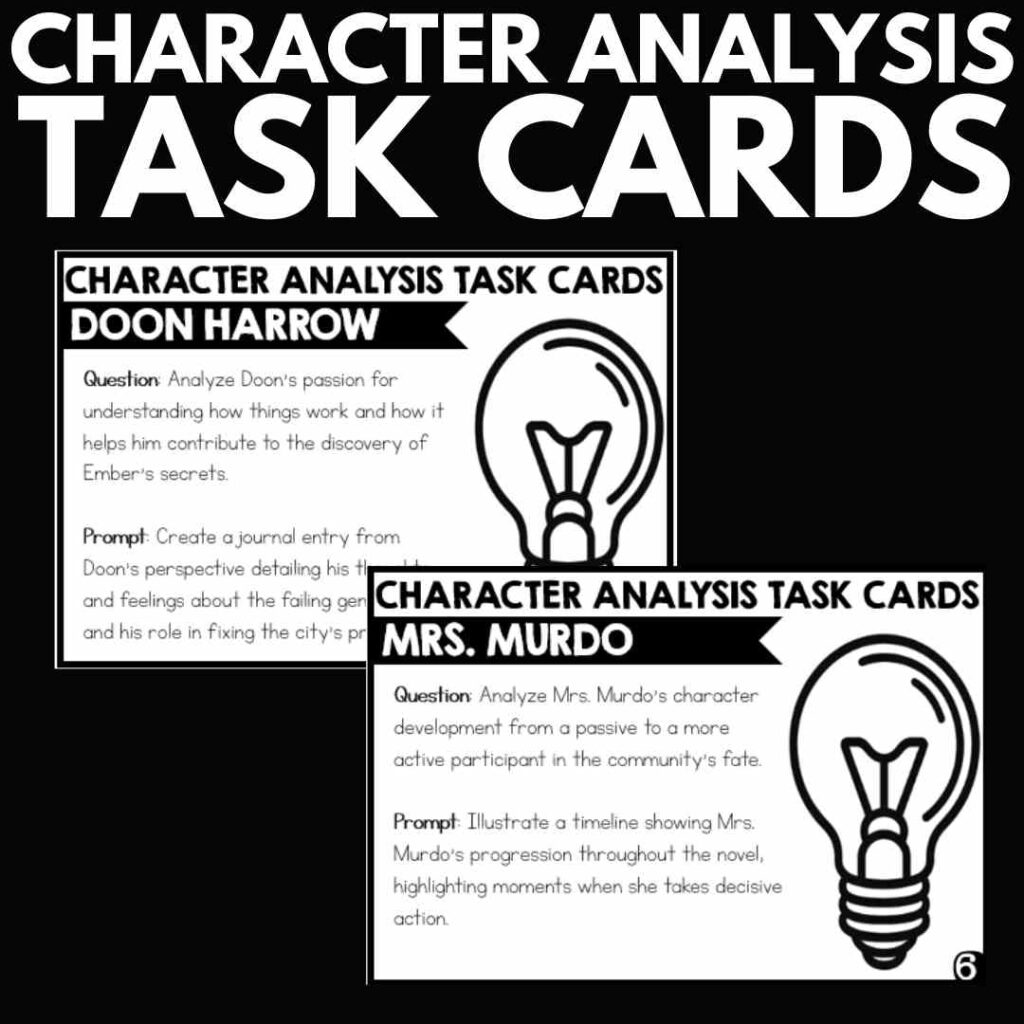Ultimate Guide to Character Analysis
By MARISSA DESPINS Updated June 10, 2024
When teaching fiction, character analysis is crucially important. Without understanding the characters, a story is just a series of events. Character analysis lets readers and writers explore the psychological intricacies and social implications of a character’s actions, making their journeys resonate on a personal level.
A successful character analysis gives insight into the complex nature of human behavior as reflected in literature. This detailed examination helps us appreciate the nuances of a character’s development and their contribution to the overall theme of a work. Understanding characters is fundamental to appreciating literature because it mirrors the complexity of our own human experiences.

In this ultimate guide to character analysis, we’ll break down the elements that bring characters to life. Through this, we will sharpen the analytical skills of your students and deepen their understanding of literary characters.
Understanding the Purpose of Character Analysis
Character analysis is essential for understanding literature. It allows us to explore the traits, motivations, actions, and growth of characters in a story. By analyzing characters, readers can uncover the complexities and contributions these figures make to the plot and understand the author’s intentions behind their creation. This process gives a deeper understanding of both the characters and the story, highlighting each character’s intricacies.
Why is character analysis important in literature?
Exploring characters’ behaviors, motivations, personalities, and interactions paints a detailed portrait that, combined with their narrative situations, reveals key aspects of human experience and emotion. Engaging in character analysis enables a deeper appreciation of the characters and their evolution. This, in turn, enriches the reader’s understanding of the narrative and its underlying themes.

Key Elements of Character Analysis
Character analysis is like assembling a complex puzzle. Every piece—challenges faced, interactions with other characters, and the environment in which the character operates—contributes to a complete portrait of the literary figure. At the core of character analysis is the study of how characters respond to adversity, whether it be internal struggles or external opposition. These responses show us the character’s journey, highlighting their growth, vulnerabilities, and resistance or ability to change.
Establishing the Character’s Role in the Story
Exploring a character’s journey is key to understanding how they change or stay the same throughout the story. Their path is shaped by significant events that test and mold them. By looking at how a character moves through the plot—making choices, building relationships, and facing conflicts—we get a deeper understanding of their role. This includes seeing if they take on leadership roles, how they interact with others, and noticing traits like pride that affect their behavior and place in the story.
Analyzing the Character’s Physical Appearance
A character’s outward appearance often shapes how the audience perceives them, with their physical traits hinting at deeper truths in the story. Through detailed descriptions like age, body type, and ethnicity, authors provide clues that help readers understand the character’s traits and motivations. These subtle hints can reveal a character’s mental state or hint at their future, encouraging readers to engage more deeply with the text.
For more information, check out our complete guide to understanding character traits.
Examining the Character’s Personality Traits and Behaviors
Personality traits, both internal like beliefs and values, and external like actions, drive a character’s narrative. By examining these traits, we uncover the basis for their decisions and reactions to the world. Character analysis goes beyond just listing these traits; it looks at how a character’s inner thoughts and outward behavior interact and shape their journey. While main characters give us lots to explore, minor characters need careful attention to small details to understand them fully.
Looking for a detailed list of character traits that you can use with your learners? Download this FREE Character Trait resource by clicking on the image or button below. This resource contains a complete list of character traits along with a fun character trait wheel activity.
Uncovering the Character’s Motivations and Goals
Character analysis aims to understand a character’s deeper drives—their hopes, fears, and the experiences that lead to their transformation or downfall. Identifying the type of arc a character follows, whether it’s a journey of self-discovery or a tragic path, helps explain their actions and decisions. Major events, like personal triumphs or devastating losses, often trigger changes in a character’s motives. By examining what drives a character’s goals and choices, we can better understand their behavior throughout the story.
Types of Characters in Literature
Characters are the center around which a story revolves. Their types vary widely, shaping the plot with their actions and personalities. Key characters like protagonists and antagonists drive the storyline, while major and minor characters add depth, enriching the narrative. Stock characters, the familiar stereotypes in genres like romance or mystery, play roles that move the plot in predictable ways. Static characters stay the same throughout the story, providing stability and a benchmark for others. Meanwhile, dynamic characters captivate readers with their growth and change, often reflecting the story’s emotional and thematic heart.
Dynamic Characters: Exploring Growth and Change
Dynamic characters are the heart of a story’s power to change. They go through significant transformations, shaped by the events in the story. These characters embark on journeys—whether physical, emotional, or spiritual—that lead to their growth, often resonating with readers. Analyzing dynamic characters is essential because their arcs show their journey from innocence to awareness or weakness to strength. Key to this analysis is identifying the crucial events that drive their transformation, shaping their resolution or downfall in the story.

Static Characters: Examining Consistency and Lack of Change
Static characters serve as the steady anchors in a story, standing firm against the changes that dynamic characters experience. These characters, with their consistent nature, provide a constant backdrop to the unfolding drama. Analyzing static characters focuses on their stable traits and how these contribute to the storyline, often serving as a foil or catalyst without undergoing significant changes themselves. Notable examples, like the ever-logical Sherlock Holmes or the determined Lady Macbeth, show characters who remain steadfast from start to finish. Static characters play crucial roles and are key to understanding the unchanging aspects of human nature or societal archetypes.
Major Characters: Central Figures in the Story
Major characters dominate the pages of any story, acting as the linchpins to the central themes and conflicts. These characters—whether protagonists, antagonists, or key supporting roles—are crafted to carry the weight of the plot. Major characters are often multi-dimensional, offering a window into their minds as they navigate complex interactions and challenges. By analyzing these characters, we gain insights into their development, ambitions, and ultimate fates, which shape our understanding of the story’s goals and significance.
Stock Characters: Recognizable and Stereotypical Figures
Stock characters are the classic prototypes of storytelling, easily recognizable and instantly connecting with the audience. They serve specific functions, like the foolish sidekick or the wise mentor, and are defined by familiar traits that drive the plot without needing character development. Lady Macbeth, as a dark and tragic figure, is an example of a timeless type—a stock character whose predefined role is crucial to the narrative. Despite their simplicity, stock characters are essential in storytelling, ensuring that certain plot elements unfold in ways the audience expects.
Conducting a Character Analysis
Character analysis is a key part of studying literature, focusing on the unique makeup of characters in a story. It involves closely examining a character’s traits, motivations, development, and their impact on the overall narrative. When doing a character analysis, it’s important to go beyond just summarizing their role and instead delve into their deeper attributes and significance. This means outlining their personalities and traits, as well as interpreting their struggles, challenges, and relationships with other characters. To do this effectively, you need to focus on the specifics of the character while also considering the narrative environment that shapes them.
For a detailed list of creative character analysis activities that you can use with your learners, check out these fun ideas!
Choosing a Character for Analysis
The best candidates for character analysis are usually dynamic characters who show a range of emotions and behaviors that drive the plot. While flat characters, who are simple and underdeveloped, can be studied, they don’t offer as much depth. It’s better to choose a character who plays a key role in the story and has complex motivations and actions that are crucial to the plot. These characters, who go beyond simple good or evil, provide a more nuanced and insightful subject for analysis.
Gathering Evidence: Examining the Character’s Words and Actions
A key step in character analysis is gathering evidence to support your insights. This evidence often comes from the character’s dialogue, reactions to events, personal thoughts, emotional responses, and changes in behavior. Other characters’ perspectives on the subject can also provide a deeper understanding. By carefully examining the text, students can document detailed character traits, using analysis charts to track developments chapter by chapter. A strong character analysis includes key pieces of evidence, such as direct quotes from the text, to support the thesis statement that summarizes the character’s journey.
Analyzing the Character’s Relationships and Interactions
Relationships and interactions with other characters offer deep insights into a character’s habits, roles, and personal traits. It’s important to pay attention to what the character says and how they say it, as this can reveal their social standing, sincerity, and hidden motivations. Observing the character’s behavior in different interactions—how they influence or are influenced by others—can uncover the essence of their personality. The way these relationships evolve or stay the same throughout the story can also show whether the character is dynamic or static, a key aspect of character analysis.
Examining the Character’s Arc: Changes and Development
Investigating a character’s narrative arc is crucial to character analysis, focusing on how they change, grow, regress, or stay the same. These changes or consistencies help flesh out a character’s persona within the story. Identifying key moments that drive changes in the character can reveal the reasons behind important decisions and shifts in the plot. Understanding whether a character’s arc is positive, negative, or static gives deeper insight into their role and the path of their personal journey within the story.
Techniques for Effective Character Analysis
Character analysis is a multifaceted technique used to understand the complexity of individuals in literature and film. The effectiveness of this approach is enhanced by several key methods:

Focus on the Character’s Traits and Development: Break down the different aspects of a character’s personality to understand their core qualities and how they change or stay the same throughout the story.
Use of Comparative Analysis: Comparing characters can highlight their unique traits or roles. Look at how the protagonist differs from the antagonist to better understand their significance.
Support with Textual Evidence: Be specific. Use direct quotes, actions, decisions, and other details from the text to back up your analysis. This makes your points more convincing.
Link Character to Themes: Explore how the character reflects the broader themes of the work. Consider what their experiences and traits reveal about the underlying messages or social commentary of the piece.
Examples of Character Analysis
A thorough character analysis uses specific character types to illustrate arguments, always backed by evidence and quotes from the text. It avoids summarizing the plot and instead connects the complexities of a character to the larger storyline, themes, and even real-life parallels where appropriate. This holistic approach not only deepens our understanding of the character but also enriches our perception of the human condition as seen through fiction.
Character Analysis of Katniss Everdeen in The Hunger Games
Katniss Everdeen in Suzanne Collins’ gripping novel, “The Hunger Games,” is a quintessential example of a strong and resilient protagonist. Raised in the impoverished District 12, Katniss is thrust into the brutal world of the Hunger Games, where her survival skills, bravery, and sense of justice are put to the test. Throughout the series, she evolves from a resourceful survivor focused solely on protecting her family to a symbol of rebellion against the oppressive Capitol.
Conducting a character analysis of Katniss involves delving into her personal struggles and the external forces that shape her journey. From the outset, Katniss is driven by a fierce protectiveness over her sister, Prim, and a profound distrust of the Capitol’s authority. These motivations underpin her actions and decisions, illustrating her complex relationship with the dystopian society in which she lives. Katniss’s experiences in the arena and her interactions with other tributes and allies reveal her growth from a wary and independent hunter to a leader who inspires and unites others against tyranny.
Katniss’s character development is marked by her increasing awareness of her symbolic role in the rebellion. Initially, she is reluctant to embrace this role, focusing instead on immediate survival and the well-being of her loved ones. However, her empathy, sense of justice, and encounters with the harsh realities of the Games and the Capitol’s cruelty push her towards becoming a reluctant hero. Her relationships with characters like Peeta, Gale, and Rue further highlight her inner conflicts and capacity for deep emotional connections, despite the constant threat of loss and betrayal.
Throughout the series, Katniss’s internal and external conflicts drive her evolution. Her struggle with PTSD, moral dilemmas about taking lives, and the manipulation by figures of power like President Snow and Coin illustrate her complexity as a character. Katniss’s journey from a survivalist to the Mockingjay, a symbol of hope and resistance, underscores themes of sacrifice, loyalty, and the fight for justice.
Analyzing Katniss Everdeen involves tracking her transformation from a reluctant participant in the Capitol’s cruel games to a powerful symbol of resistance. Her character embodies the fight against oppression, the importance of personal integrity, and the strength found in unity. Katniss Everdeen’s story is a testament to the impact one individual can have in challenging injustice and inspiring change.
For additional information on Katniss, and ways to use this engaging novel in your classroom, check out out guide to using The Hunger Games in the classroom.
Wrapping Up
I hope you enjoyed this look at character analysis in literature, emphasizing its importance in understanding stories beyond just their events. It explains how character analysis explores psychological and social complexities, motivations, and growth, enhancing appreciation of the narrative and its themes.
Looking for ready to teach character analysis activities that you can print and use with your learners? Click on the image or button below to see all of the different character analysis activities available in my TPT shop!
Interested in signing up for my email list?
If you are interested in signing up for my email list, you can do so by clicking on the link below. I periodically send out emails with free resources, teaching tips, and exclusive deals. Signing up will also give you immediate access to some of my best selling Interactive Notebook resources – foldable activities, graphic organizers, and other fun activities.








